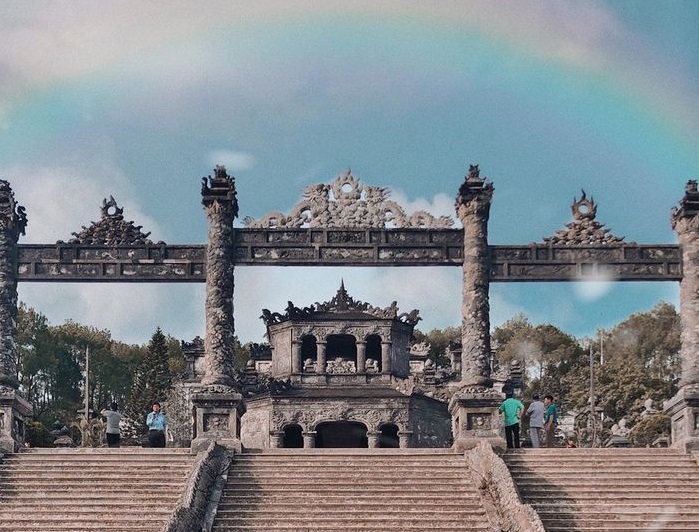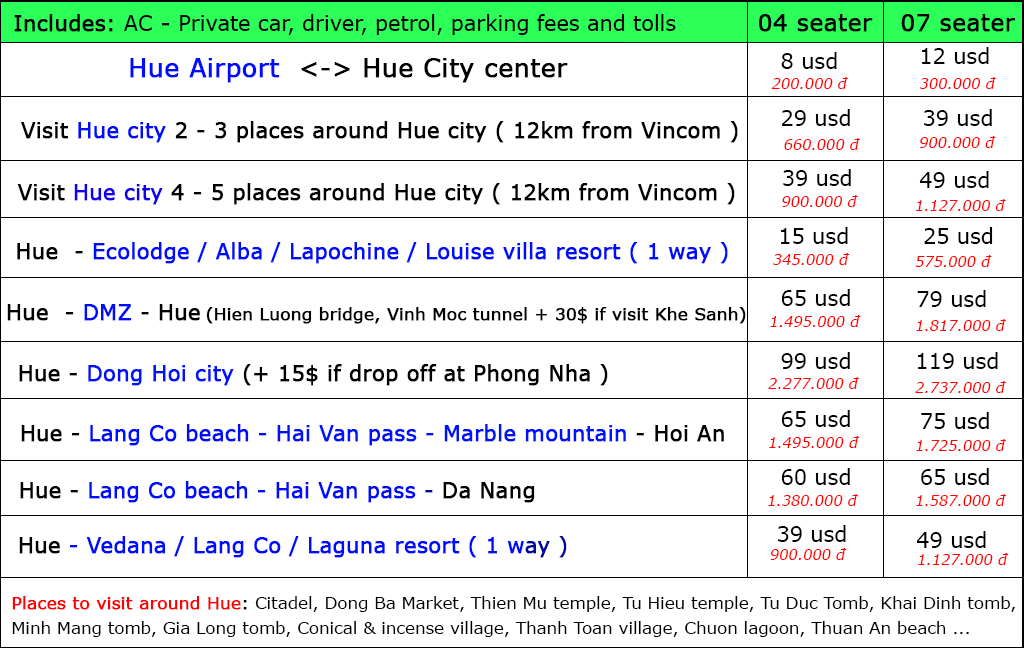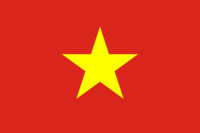Khai Dinh Tomb Hue – The Pinnacle of Nguyen Dynasty Tomb Architecture
When you visit the dreamy land of Hue, make sure not to miss the Khai Dinh Tomb – a breathtaking check-in spot renowned for its intricate and artistically designed architecture.
1. Introduction to Khai Dinh resting place. The tomb, also known as Ung Lang, is one of the seven most beautiful tombs in Hue and serves as the final resting place of the 12th Nguyen Dynasty emperor, Khai Dinh. Located in Thuy Bang commune, Huong Thuy district, Thua Thien Hue province, atop Chau Chu Mountain, approximately 10km from the city center of Hue, Khai Dinh Tomb offers a captivating experience for tourists exploring Hue. To ensure a complete visit to Khai Dinh Tomb, many travel enthusiasts recommend staying in the city center for convenient access.

2. Construction Process and Architecture of Khai Dinh Tomb
2.1. Construction of Khai Dinh resting place in Hue Construction of the Tomb in Hue commenced on September 4, 1920, and it took 11 years to complete this magnificent tomb. Despite its relatively small size (117m x 48.5m), tomb required extensive time, effort, and financial resources to complete. The tomb showcases sophisticated and exquisite architectural design.
2.2. Architectural Features of Khai Dinh Mausoleum in Hue. The preserves significant historical, cultural, and artistic values, representing the convergence of Vietnamese and Western cultures during a notable period. The overall layout of Khai Dinh Tomb is rectangular and consists of 127 steps leading up to the Tam Quan Gate, followed by Nghi Mon Gate and Bai Dinh Courtyard. Above these levels are two terraces, each separated by 13 steps, with the Thien Dinh Palace situated at the highest point.
Khai Dinh Tomb features a harmonious fusion of Eastern and Western architectural styles, combining classical and modern elements. Additionally, it is nestled in a rich and diverse natural environment with surrounding hills, valleys, and streams, creating a majestic natural backdrop. These factors make Khai Dinh Tomb the most unique among the royal tombs in Vietnam.
3. Prominent Areas to Explore Inside Khai Dinh Tomb
3.1. Tam Quan Gate Tam Quan Gate stands out with its majestic and solemn architectural style, serving as the entrance to the Tomb. Visitors need to ascend 37 initial steps to reach this area. The pillars at the Tam Quan Gate are built in the style of Indian architecture, showcasing a unique blend of Vietnamese and Indian cultures.
3.2. Nghi Mon and Bai Dinh Courtyard From the Tam Quan Gate, you’ll ascend 29 more steps to reach the Nghi Mon and Bai Dinh Courtyard area. Here, you’ll be mesmerized by the intricate statues of mythical creatures and soldiers arranged symmetrically in four rows, all meticulously crafted.
3.3. Exploring the Thien Dinh Palace at the tomb of Khai Dinh After passing through the transitional levels (floors 3 and 4) inside Khai Dinh Tomb in Hue, you’ll arrive at the Thien Dinh Palace on the fifth and highest floor. This is the burial place of Emperor Khai Dinh and the most unique area for exploration, showcasing the creativity, innovation, and artistic appreciation of Emperor Khai Dinh.
3.4. Experience the Unique Architecture of Khai Thanh Palace Inside the Tomb Khai Thanh Palace is a part of the Thien Dinh Palace and houses the emperor’s altar and remains. The architecture of Khai Thanh Palace reflects precision and sophistication. In the center of Khai Thanh Palace is the main burial chamber, with a 1-ton Buu Tan made of reinforced concrete that appears remarkably graceful and delicate.
3.5. Admire the Emperor Khai Dinh Bronze Statues Inside the Tomb is renowned for breaking from tradition by housing two bronze statues of Emperor Khai Dinh inside the tomb itself, each crafted to a 1:1 scale. Other royal tombs typically do not feature statues of the emperor within the tomb.
Inside the tomb, you’ll find two bronze statues: one seated on a golden throne in Khai Thanh Palace and another standing.
The seated bronze statue on the golden throne in Khai Thanh Palace was sculpted by two French artists in 1920, with Vietnamese craftsmen later applying gold leaf to the statue. The standing bronze statue was cast by a skilled artisan from Quang Nam, originally placed in Cung An Dinh, and later relocated to Cung Thien Dinh in 1975.
4. Detailed Guide for Visiting Khai Dinh Tomb

4.1. Best Time to Visit Khai Dinh Tomb in Hue To make the most of your visit to Khai Dinh area it is advisable to travel to Hue between January and February. During this period, the weather in Hue is pleasant, with neither heavy rain nor excessive heat, making it ideal for exploring historical landmarks.
4.2. Getting to Khai Dinh Tomb is conveniently located relatively close to the city center of Hue, approximately 9km away. Therefore, transportation is quite convenient. From the central area of Hue, head west towards Hanoi Road, then proceed on Ngo Quyen Street, followed by Dien Bien Phu Street and Minh Mang Street to reach Khai Dinh Tomb. You can choose from various modes of transportation, including motorcycles, cars, buses, or taxis. When opting for a taxi, it is recommended to use the XANH SM taxi service for the best travel experience.
Another easy way is take a private car with English speaking driver: Explore Hue by Hue private car

4.3. Ticket Prices for Khai Dinh Tomb
Ticket prices for the tomb in Hue are as follows: 150,000 VND per adult
4.4. What to Keep in Mind When Visiting Khai Dinh Tomb in Hue?
- When visiting, be aware of the steepness of the three-tiered steps, which can be tiring and pose a risk of tripping and falling.
- The tomb is known for being a picturesque check-in spot in Hue with many beautiful photo opportunities. Consider exploring some of the best photo spots before visiting the tomb for the most stunning shots.
- Before your visit to Khai Dinh Tomb, take some time to learn about the life of Emperor Khai Dinh to gain a deeper understanding of his life and the tomb’s architecture.
- Adjust your camera’s brightness settings when taking photos inside Khai Thanh Palace, as it can be quite dark.
Khai Dinh Tomb in Hue is a remarkable architectural achievement within the heritage of Hue’s ancient capital. It is recognized as one of the most splendid achievements in the history of Vietnamese architecture and a must-visit attraction for travelers exploring Hue.
Please let me know if you need any further information or if you would like me to provide additional details
See more:

